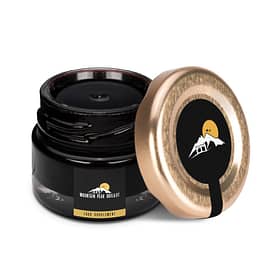Microbiological Report

Client :
Gilgit Shilajit Ltd
United Kingdom
Certificate Code :
Page Number :
Reported On :
Po reference :
Reported By :
AR-24-UD-037662-01
page 1 of 1
24/01/2024
n/a
Pathogen Laboratory Team Leader CUK003
Certificate Of Analysis
Simple Number :
Simple Code :
Your Simple Reference :
400-2024-00033282
24-ABD-766
Shilajit Resin
Received On :
Analysis Started On :
18/01/2024
19/01/2024
Test Code
UMPEC
UMWHQ
UMWXK
UMXOF
UMXOF
ZMBSU Salmonella
Analyte
Presumptive Enterobacteriaceae 37°C
Escherichia coli B-Glucuronidase+
Presumptive Bacillus cereus 30°C
Moulds 25°C
Yeasts 25°C
Yeasts 25°C
Result Unite
<10 cfu/g
<10 cfu/g
<10 cfu/g
<10 cfu/g
<10 cfu/g
Not Detected /25 g n\a
Method Ref
EUMM3.05
EUMM3.25
EUMM3.03
EUMM3.16
EUMM3.16
EUMM3.83
Simplified Lab Report for Shilajit Resin Sample
Received Date: January 18, 2024
Sample Code: 24-ABD-766
Analysis Start Date: January 19, 2024
Sample Reference: Shilajit Resin
Test Results Summary:
Enterobacteriaceae (Presumptive Test)
Results: Less than 10 colony-forming units per gram (cfu/g)
Temperature: 37°C
Method Reference: EUMM3.05
Notes: Indicates very low levels of Enterobacteriaceae, suggesting good microbial quality.
Escherichia coli (E. coli)
Results: Less than 10 cfu/g
Method Reference: EUMM3.25
Notes: E. coli levels are minimal, indicating low contamination risk.
Presumptive Bacillus cereus
Results: Less than 10 cfu/g
Temperature: 30°C
Method Reference: EUMM3.03
Notes: Bacillus cereus levels are very low, suggesting the sample is safe in this aspect.
Moulds
Results: Less than 10 cfu/g
Temperature: 25°C
Method Reference: EUMM3.16
Notes: Mould levels are minimal, indicating good fungal quality.
Yeasts
Results: Less than 10 cfu/g
Temperature: 25°C
Method Reference: EUMM3.16
Notes: Yeast levels are very low, which is good for product quality.
Salmonella
Results: Not Detected in 25 grams
Method Reference: EUMM3.83
Notes: No Salmonella detected, indicating excellent microbial safety.
Our Shilajit Resin sample shows very low levels of various microorganisms, including Enterobacteriaceae, E. coli, Bacillus cereus, moulds, and yeasts, all below 10 cfu/g.
Additionally, Salmonella was not detected.
UK and Europe Food Safety Standards:
In the UK and Europe, the European Food Safety Authority (EFSA) sets out the microbiological criteria for foodstuffs. The results from our lab report, particularly for pathogens like Escherichia coli (E. coli) and Salmonella, are crucial. The detection of less than 10 colony-forming units per gram (cfu/g) for E. coli and the absence of Salmonella in 25 grams of the sample are excellent indicators. According to EFSA guidelines, the absence of Salmonella in 25g samples is a common requirement for many food products, and low levels of E. coli are often used as an indicator of general hygiene and fecal contamination.
For Bacillus cereus, moulds, and yeasts, the levels detected are also below 10 cfu/g, which shows good quality, although specific limits can vary depending on the type of food product. The EFSA and national regulations provide guidelines on acceptable levels for these microorganisms, often depending on the specific food category.
USA Food Safety Standards:
In the USA, the Food and Drug Administration (FDA) and the United States Department of Agriculture (USDA) set the food safety standards. Similar to European standards, the absence of Salmonella in food products is a key safety criterion. The FDA’s guidelines for E. coli levels vary depending on the food product, but low levels are generally seen as indicative of good sanitary practices during food production and processing.
For Bacillus cereus, moulds, and yeasts, the FDA does not have specific actionable levels for all food types, but these microorganisms are monitored due to their potential to cause food spoilage or, in some cases, foodborne illness. The detected levels below 10 cfu/g would be considered acceptable for many food products.
The lab report suggests that the Shilajit Resin sample has low microbial levels. The absence of Salmonella and low levels of E. coli, Bacillus cereus, moulds, and yeasts shows that the sample meets key safety criteria relevant to both European and American standards.
For a definitive interpretation, it would be advisable to consult with a food safety expert or refer to the specific regulations and guidelines provided by the relevant food safety authorities in the UK, Europe, and the USA.




